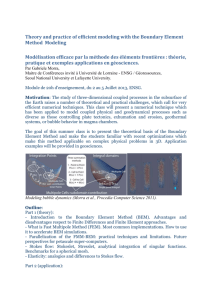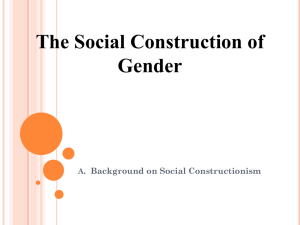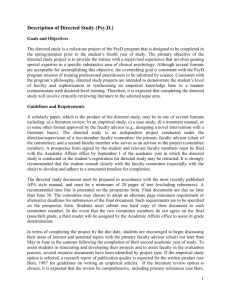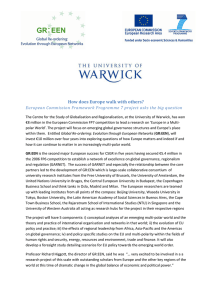Research Journal of Applied Sciences, Engineering and Technology 6(11): 2072-2076,... ISSN: 2040-7459; e-ISSN: 2040-7467
advertisement
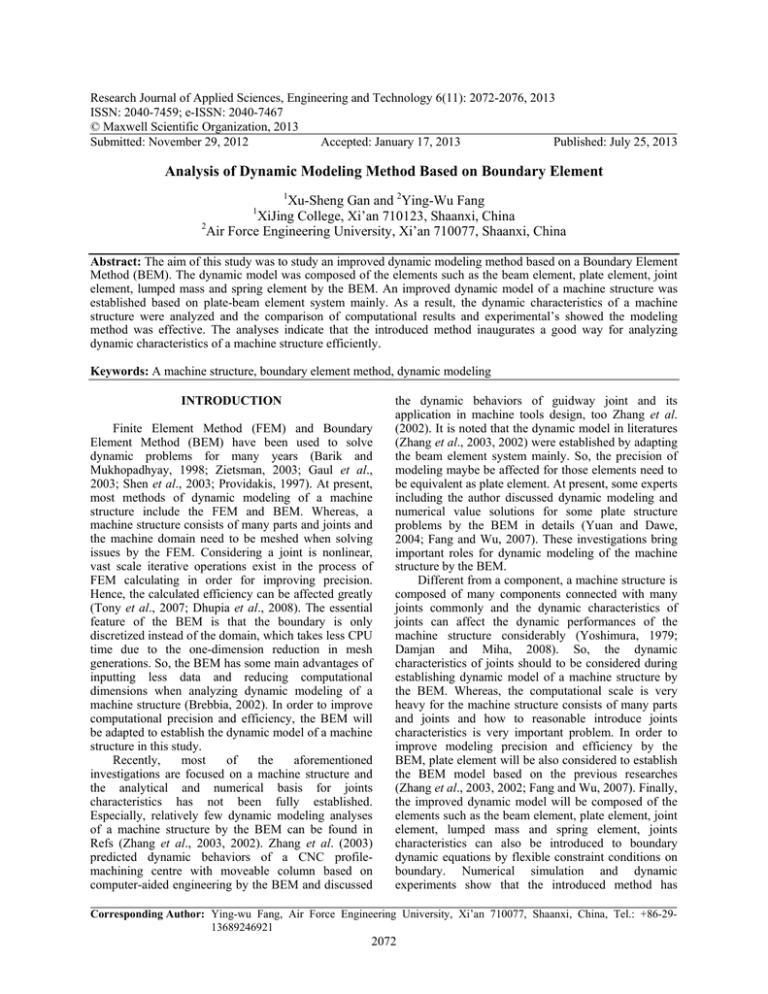
Research Journal of Applied Sciences, Engineering and Technology 6(11): 2072-2076, 2013 ISSN: 2040-7459; e-ISSN: 2040-7467 © Maxwell Scientific Organization, 2013 Submitted: November 29, 2012 Accepted: January 17, 2013 Published: July 25, 2013 Analysis of Dynamic Modeling Method Based on Boundary Element 1 Xu-Sheng Gan and 2Ying-Wu Fang XiJing College, Xi’an 710123, Shaanxi, China 2 Air Force Engineering University, Xi’an 710077, Shaanxi, China 1 Abstract: The aim of this study was to study an improved dynamic modeling method based on a Boundary Element Method (BEM). The dynamic model was composed of the elements such as the beam element, plate element, joint element, lumped mass and spring element by the BEM. An improved dynamic model of a machine structure was established based on plate-beam element system mainly. As a result, the dynamic characteristics of a machine structure were analyzed and the comparison of computational results and experimental’s showed the modeling method was effective. The analyses indicate that the introduced method inaugurates a good way for analyzing dynamic characteristics of a machine structure efficiently. Keywords: A machine structure, boundary element method, dynamic modeling INTRODUCTION Finite Element Method (FEM) and Boundary Element Method (BEM) have been used to solve dynamic problems for many years (Barik and Mukhopadhyay, 1998; Zietsman, 2003; Gaul et al., 2003; Shen et al., 2003; Providakis, 1997). At present, most methods of dynamic modeling of a machine structure include the FEM and BEM. Whereas, a machine structure consists of many parts and joints and the machine domain need to be meshed when solving issues by the FEM. Considering a joint is nonlinear, vast scale iterative operations exist in the process of FEM calculating in order for improving precision. Hence, the calculated efficiency can be affected greatly (Tony et al., 2007; Dhupia et al., 2008). The essential feature of the BEM is that the boundary is only discretized instead of the domain, which takes less CPU time due to the one-dimension reduction in mesh generations. So, the BEM has some main advantages of inputting less data and reducing computational dimensions when analyzing dynamic modeling of a machine structure (Brebbia, 2002). In order to improve computational precision and efficiency, the BEM will be adapted to establish the dynamic model of a machine structure in this study. Recently, most of the aforementioned investigations are focused on a machine structure and the analytical and numerical basis for joints characteristics has not been fully established. Especially, relatively few dynamic modeling analyses of a machine structure by the BEM can be found in Refs (Zhang et al., 2003, 2002). Zhang et al. (2003) predicted dynamic behaviors of a CNC profilemachining centre with moveable column based on computer-aided engineering by the BEM and discussed the dynamic behaviors of guidway joint and its application in machine tools design, too Zhang et al. (2002). It is noted that the dynamic model in literatures (Zhang et al., 2003, 2002) were established by adapting the beam element system mainly. So, the precision of modeling maybe be affected for those elements need to be equivalent as plate element. At present, some experts including the author discussed dynamic modeling and numerical value solutions for some plate structure problems by the BEM in details (Yuan and Dawe, 2004; Fang and Wu, 2007). These investigations bring important roles for dynamic modeling of the machine structure by the BEM. Different from a component, a machine structure is composed of many components connected with many joints commonly and the dynamic characteristics of joints can affect the dynamic performances of the machine structure considerably (Yoshimura, 1979; Damjan and Miha, 2008). So, the dynamic characteristics of joints should to be considered during establishing dynamic model of a machine structure by the BEM. Whereas, the computational scale is very heavy for the machine structure consists of many parts and joints and how to reasonable introduce joints characteristics is very important problem. In order to improve modeling precision and efficiency by the BEM, plate element will be also considered to establish the BEM model based on the previous researches (Zhang et al., 2003, 2002; Fang and Wu, 2007). Finally, the improved dynamic model will be composed of the elements such as the beam element, plate element, joint element, lumped mass and spring element, joints characteristics can also be introduced to boundary dynamic equations by flexible constraint conditions on boundary. Numerical simulation and dynamic experiments show that the introduced method has Corresponding Author: Ying-wu Fang, Air Force Engineering University, Xi’an 710077, Shaanxi, China, Tel.: +86-2913689246921 2072 Res. J. Appl. Sci. Eng. Technol., 6(11): 2072-2076, 2013 excellent precision and efficiency and can realize high efficiency computation under satisfying good accuracy conditions. Thereby, this study will study an improved dynamic modeling method of a machine structure by BEM. Substitute Eq. (3) into (8) results in: EE n − r 11,i 21,i EE n − r 0 0 A MACHINE STRUCTURE MODEL 0 12 , j +1 EE n − r +1 22 , j +1 EE n − r +1 12 ,i +1 S − EE n − r 22 ,i +1 S − EE n − r 11, j EE n − r +1 EE n − r +1 0 21, j (5) U Tn − r i n − ri +1 U n−r j Tn − r +1 = j + 1 j T U n − r +1 j +1 n − r +1 U n − r +1 i In this section, dynamic modeling of a machine structure will be established by the BEM. As an example, let a machine structure be composed of m parts. The modeling process of parts No. n-r, No. n-r+1 are illustrated as follows. According to the literatures (Fang and Wu, 2007), the governing boundary equations of parts No. n-r, No. n-r+1 are written: EE n − r 11,i 21,i EE n − r 12 ,i +1 EE n − r 22 ,i +1 EE n − r Tn − r i = i +1 Tn − r EE n − r +111, j 21, j EE n − r +1 Equation (5) is substituted into Eq. (3) and the following equations can be gotten after being dealt with: j [RR U n−r i i +1 U n − r 12 EEn − r [RE11 12 , j +1 EE n − r +1 22 , j +1 EE n − r +1 (2) j where, EE : The coefficient matrix on boundary, the subscript sign of each matrix denotes serial number of parts U, T: The corresponding matrix and the subscript sign g denotes the joint surface elements in domain RR12 RR13 21, i + RR12 EEn − r 12 , j +1 RR13 EEn − r +1 ]T T 22 , i +1 S ] −1 = j +1 n − r +1 i (6) n−r T i RE22 ] n − r j +1 Tn − r +1 12 , i + 1 EEn − r11, i − EEn − r12, i +1 SRE11 SRE22 − EEn − r 21, i 22 , i +1 22 , i +1 EE EE SRE EE SRE − − 11 22 n−r n−r n−r 11, j 12 , j + 1 12 , j + 1 EEn − r +1 RE11 EEn − r +1 RE22 (7) + EEn − r +1 21, j 22 , j + 1 22 , j + 1 EEn − r +1 RE11 EEn − r +1 RE22 + EEn − r +1 Un −ri Tn − r i U n − r i +1 = j j +1 Tn − r +1 U n − r +1 j +1 U n − r +1 According to the relation of space coordination transforming matrix on boundary a, Eq. (4) can be denoted the following form after being dealt with: [0 11, j Equation (6) is substituted into Eq. (5) and the boundary dynamic equations of part No. n-r, No. n-r+1 are gotten after being dealt with: Tn − r +1 U n − r +1 = j +1 j +1 Tn − r +1 U n − r +1 j [ Tn − r +1 = I − RR13 EEn − r +1 (1) U n− r i i +1 U 0 ] n − r j = Tn − r +1 j U n − r +1 j +1 U n − r +1 (3) where, RR denotes the joints complex stiffness matrix, RR 12 = -S a jKC a S a i+1, RR 13 = S a jKC a S a j. Equation (5) and (6) are combined and the following equations can be gotten: For a machine structure is composed of many components connected with many joints, Eq. (7) can be combined unceasingly according to the joints conditions. Repeating above process until finishing assembled process, the final dynamic equations of a machine structure can be established and the dynamic characteristics of the machine structure can be gotten by solving Eq. (7). EXAMPLE COMPUTATION EEn − r 21,i EEn − r 0 0 11, i 12 ,i +1 EEn − r 22 ,i +1 EEn − r 0 0 0 0 11, j n − r +1 21, j n − r +1 EE EE Tn − r i U n − r i i +1 i +1 Tn − r U n − r j j = Tn − r +1 U n − r +1 j +1 j +1 U n − r +1 Tn − r +1 12 , j +1 EEn − r +1 22 , j +1 EEn − r +1 0 0 (4) According to the above modeling process of a machine structure, the corresponding procedure has been developed to analyze dynamic characteristics of the machine structure. In order to check the correctness of modeling method for a machine structure, the dynamic characteristics of a machine structure including bolt and cylinder joints will be discussed and the entity picture of a machine structure is shown in 2073 Res. J. Appl. Sci. Eng. Technol., 6(11): 2072-2076, 2013 Fig. 1: Entity picture of a machine structure Fig. 2: The simplified model Fig. 4: The curve of frequency characteristics calculated values of first five natural frequencies are given in Table 1. It can be seen from Fig. 3 and Table 1 that the maximum difference between the calculated values and experiments’ is 10.1% (Fig. 4). Fig. 3: The BEM calculating model EXPERIMENT VERIFICATION Table 1: Comparison of computational and experimental values Frequency Computational Experimental Relative (Hz) values values error (%) f1 4.23 3.98 6.3 f2 13.81 12.94 6.7 f3 94.06 87.50 7.5 f4 163.26 150.75 8.3 f5 208.96 189.80 10.1 Fig. 1. Considering establish dynamic modeling based on the BEM, a simplified model of the machine structure is given as shown in Fig. 2 based on the principle of modeling method proposed. In Fig. 2, the electric engine and eccentric wheel are equivalent as the lumped mass, the upright column, bed plate and support plate are equivalent as plate parts, the bridging beam are equivalent as beam parts, the ground base is equivalent as springs. The bolt joints mainly exist in bolt pontes and the cylinder joints mainly exist in the bearing and support plate. At last, the calculating model of the machine structure is established by the BEM, as shown in Fig. 3. The frequency curve is presented in Fig. 3 and the In order to verify the validity of the modeling method, the dynamic experiments was done by dynamic signal analyzer and the experimental scene and main flow chart were shown in Fig. 5 and 6. The exciting force produced by the mechanical sensor was applied at the end of spindle, the accelerometer was also mounted at the end of spindle near the exciting point, all signals were transmitted to HP3562A dynamic signal analyzer by charge amplifiers and the frequency response curve was gotten by plotter. In order to reduce experimental error and improve signal to noise ratio, the average results of ten time selfexcited test are executed in the process of dynamic experiments. At last, the curves of frequency and amplitude responses of the machine structure were obtained by the experiments, as shown in Fig. 7 and 8 and the experimental results can be found in Table 1. It can be seen from the Fig. 7 and 8 that the computation results are close to experiments’, the maximum difference between the computational and experimental values is less than 11%. So, the calculated 2074 Res. J. Appl. Sci. Eng. Technol., 6(11): 2072-2076, 2013 theoretical model used is based on the BEM, simplified dynamic model and processing joints can bring some influences for the calculated results. However, the trend observation should be valid by comparison of the computational and experimental results as shown in Table 1. CONCLUSION This study investigates the dynamic modeling method of a machine structure and the modeling process is succinct. The computed results and experiments’ showed that the calculated model has high efficiency and the maximum difference between the calculated values and experiments’ is less than 11%. Thereby, it is excellent solve modeling issues of a machine structure by the BEM. For instance, several observations have been obtained through the numerical examples: Fig. 5: Experimental scene • • Fig. 6: The flow chart of dynamic experiments Flexible conditions are introduced to the dynamic model reasonably and it provides an efficient method for solving joints nonlinear problems. The modeling thought is legible and the introduced model is very convenient to analyze the dynamic characteristics of a machine structure. Result shows the proposed method can solve BEM modeling issues of a machine structure effectively. Hence, this study lays good foundation for developing computer-aided engineering commercial software. ACKNOWLEDGMENT The authors gratefully acknowledge supports of the National Natural Science Foundation of China (No. 10972236), the Natural Science Foundation of Shaanxi Province, China (No. 2010JM6012) and the Science Foundation of China Postdoctor (No. 20100471835). Fig. 7: The curve of frequency responses REFERENCES Fig. 8: The curve of amplitude responses model and method based on the BEM are effective. At the same time, it should be pointed out that the Barik, M. and M. Mukhopadhyay, 1998. Finite element free flexural vibration analysis of arbitrary plates. Finite Elem. Anal. Design, 29: 137-151. Brebbia, C.A., 2002. Recent innovations in BEM. Eng. Anal. Bound. Elem., 26: 729-730. Damjan, C. and B. Miha, 2008. Identification of the dynamic properties of joints using frequencyresponse functions. J. Sound Vib., 317(1-2): 158-174. Dhupia, S., A.G. Ulsoy and R. Katz, 2008. Experimental identification of the nonlinear parameters of an industrial translational guide for machine performance evaluation. J. Vib. Control, 14(5): 645-668. 2075 Res. J. Appl. Sci. Eng. Technol., 6(11): 2072-2076, 2013 Fang, Y.W. and D.W. Wu, 2007. Study on dynamic behaviors of thin plate structure by DBEM. Key Eng. Mater., 353: 929-932. Gaul, L., M. Kogl and W. Marcus, 2003. Boundary Element Methods for Engineers and Scientists. Springer, Berlin, pp: 488. Providakis, C.P., 1997. Comparison of boundary element and finite element methods for dynamic analysis of elastoplastic plates. Adv. Eng. Softw., 30: 353-360. Shen, H.S., Y. Chen and J. Yang, 2003. Bending and vibration characteristics of a strengthened plate under various boundary conditions. Eng. Struct., 25: 1157-1168. Tony, L., P. Kevin, W. Dongki and D.W. Scott, 2007. Shrink fit tool holder connection stiffness/damping modeling for frequency response prediction in milling. Int. J. Mach. Tools Manuf., 47: 1368-1380. Yoshimura, M., 1979. Computer-aided design improvement of machine tool structure incorporating joint dynamic data. Ann. CIRP, 28(1): 241-246. Yuan, W.X. and D.J. Dawe, 2004. Free vibration and stability analysis of stiffened sandwich plates. Comp. Struct., 63: 123-137. Zhang, G.P., W.H. Shi and Y.M. Huang, 2002. Analysis method of dynamic behaviours of guidway joint and its application in machine tools design. Chinese J. Mech. Eng., 38(10): 114-117. Zhang, G.P., Y.M. Huang and W.H. Shi, 2003. Predicting dynamic behaviors of a machine machine tool structure based on computer-aided engineering. Int. J. Mach. Tools Manuf., 43: 699-706. Zietsman, L., 2003. Application of the finite-element method to the vibration of a rectangular plate with elastic support at the boundary. Math. Comp. Modell., 38: 309-322. 2076



